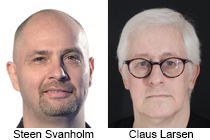Using 911facts.dk

How do you get the most out of this site?
Truth Movement
Publications
Booking

We are available for booking a lecture or a workshop here.

The National Operations Manager is lying about the air defense

Claim
“Ben Sliney is lying, when he claims, at 36 minutes and 45 seconds, that the air defense didn’t work, because “All these agencies didn’t have lines of communication between themselves.”
“Ben Sliney lyver når han 36:45 ind i programmet hævder, at luftforsvaret ikke fungerede fordi “All these agencies didn’t have lines of communication between themselves.””0
Background
The claim originated at 911facts.dk’s Facebook debate pages0 by Thomas Nørgaard, high school teacher at Nørre Gymnasium, Copenhagen, Denmark1. Thomas Nørgaard was critical of a BBC documentary about a group of members of the Truth Movement. The group gets to meet with, and ask questions to, central individuals with concrete knowledge about the terror attack on September 11, 2001.2.
The claim is used to support the overall claim that the terror attack on September 11, 2001, was a so-called inside job, where leading employees in various government agencies, specifically the American aviation authorities and the American Air Force, should have been involved in a conspiracy or, at least, in covering up who was in the conspiracy.
Ben Sliney was the National Operations Manager in the Federal Aviation Administration on September 11, 20013.
Facts
The claim is based on a quote taken out of context as well as a misunderstanding of which government authorities Sliney is talking about.
The conversation, in full (35:44):
Charlie Veitch: “So, in the United States, there is a system in place, that if a plane of any size goes off course for a while, military jets intercept them, yeah?”
Ben Sliney: “If you’ve done your homework, you’ll know that I believe we only had six interceptors available for the whole East Coast. So we didn’t have…”
Charlotte Scott-Hayes: “Normally? Is that normal?”
Ben Sliney: “We had a lot of cutbacks in budget, and they closed a lot of squadrons, and there were very few aircraft to send for that type of mission. It’s budget dollars.”
Emily Church: “Given that President Bush was aware of a plan to hijack planes, do you feel that aviation security should have been ramped up?”
Ben Sliney: “I think it was a frightful breakdown of security. We in Air Traffic Control did not know what was going on. No-one had enough of the big picture to actually put it together, I believe.”
Andrew Maxwell: “So, long story short, you think 9/11 happened because the government wasn’t talking to each other.”
Ben Sliney: “The various, CIA, all these agencies, don’t have lines of communication between themselves. They could have figured it out, there was enough evidence that they should..could have stopped it all before it started. Given what we’ve been told about the investigations and what each individual agency knew, I think it is very likely that it would have been prevented.”2
Sliney says nothing about the air defense not “working”, and there is no reason to conclude from his statements that it was the case.
Sliney does not specifically mention the air defense, but instead he describes the communication between the various government authorities, among them the CIA, and how the communication was not optimal. Sliney expands on his statement, immediately after the quoted sentence, by pointing out that nobody – not even the Air Traffic Control (ATC) – had a clear overview of the unfolding events.
It is Sliney’s personal opinion that the attack possibly could have been averted, if the relevant authorities had communicated perfectly. He explains what is also stated in the comprehensive 9/11 Commission Report4, which was published by the National Commission on Terrorist Attacks Upon the United States, better known as the “9/11 Commission”. The report established the chain of events on September 11, 2001. It was revealed that the communication lines between the various authorities was lacking, and in some cases did not exist, or could be established. The system was simply not prepared to deal with that many hijacked planes at the same time, planes that also were used in such a short time as missiles against important American targets.
Logic
Sliney’s statement, read and understood in context, is truthful, which means he is not lying.
Being accused of lying, presupposes that the person being accused of lying is also aware that what he is saying is not true. You can say something that is not true, without lying, if you are not aware that what you are saying is not true. If the claim that Sliney is lying is true, it requires evidence that Sliney is aware that what he says is not true. At no point does Thomas Nørgaard make an effort to present such evidence5.
Instead, the readers are shown a page on a web site from the Truth Movement which is pure character assassination of Sliney6. This reveals that the claim is merely an attempt of blackening Sliney’s reputation by sowing doubt about his credibility. This is also known as the logical fallacy, “Argumentum ad hominem” (attack the man, not the issue)7.
The claim also presupposes that the four planes were hijacked. This contradicts a number of other claims, often made by the Truth Movement, which require that the four planes were not hijacked (see “Related articles”).
Conclusion
The claim is therefore:
- Falso
- Manipulating
- Self-contradicting
Sources
- 911facts.dk Facebook
- Lærerstab, Ørestad Gymnasium
- 9/11: Conspiracy Road Trip, BBC (DailyMotion)
- Ben Sliney, Wikipedia
- 9/11 Commission Report
- Conspiracy Road Trip 9/11
- Why the Planes Were Not Intercepted on 9/11: The Wall Street Lawyer and the Special Ops Hijack Coordinator, 911blogger.com
- Argumentum ad hominem, Den Store Danske
Q & A

